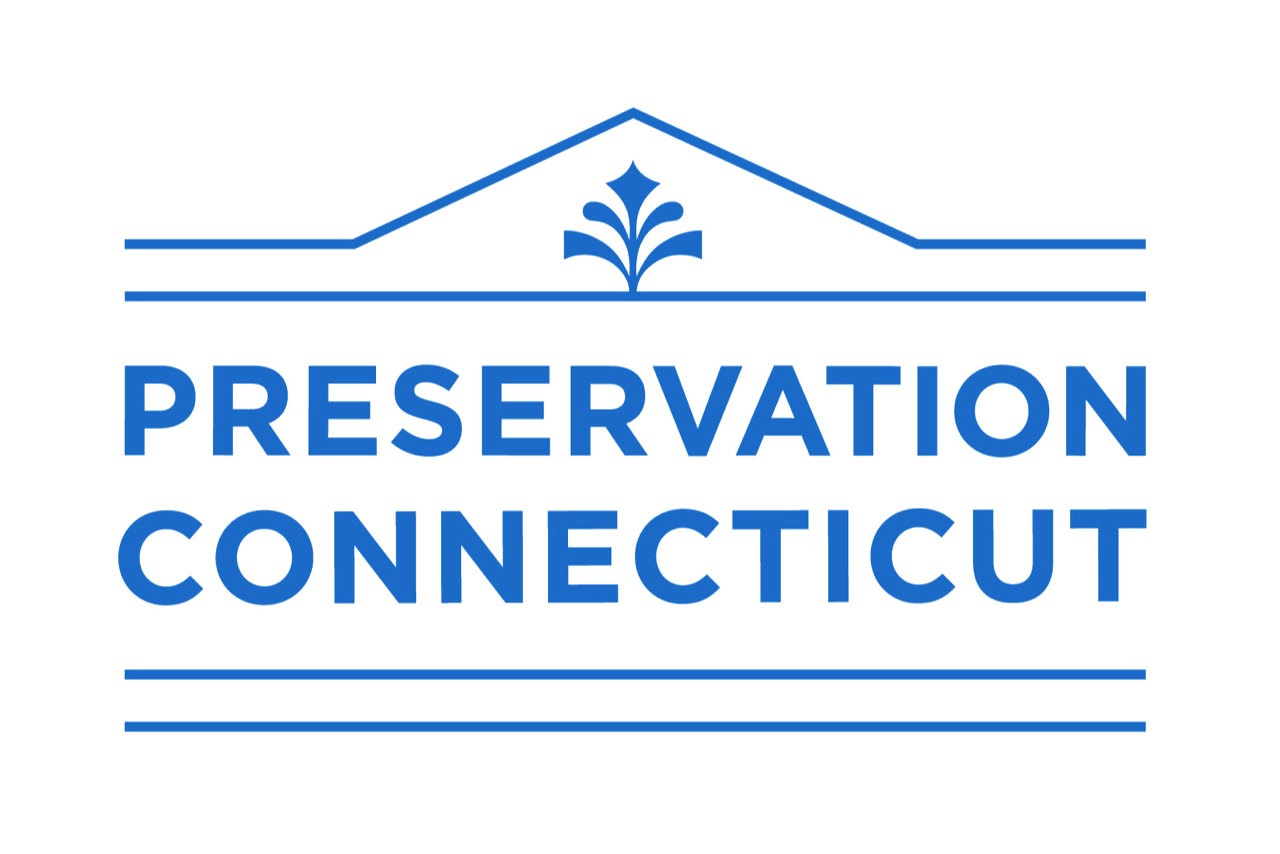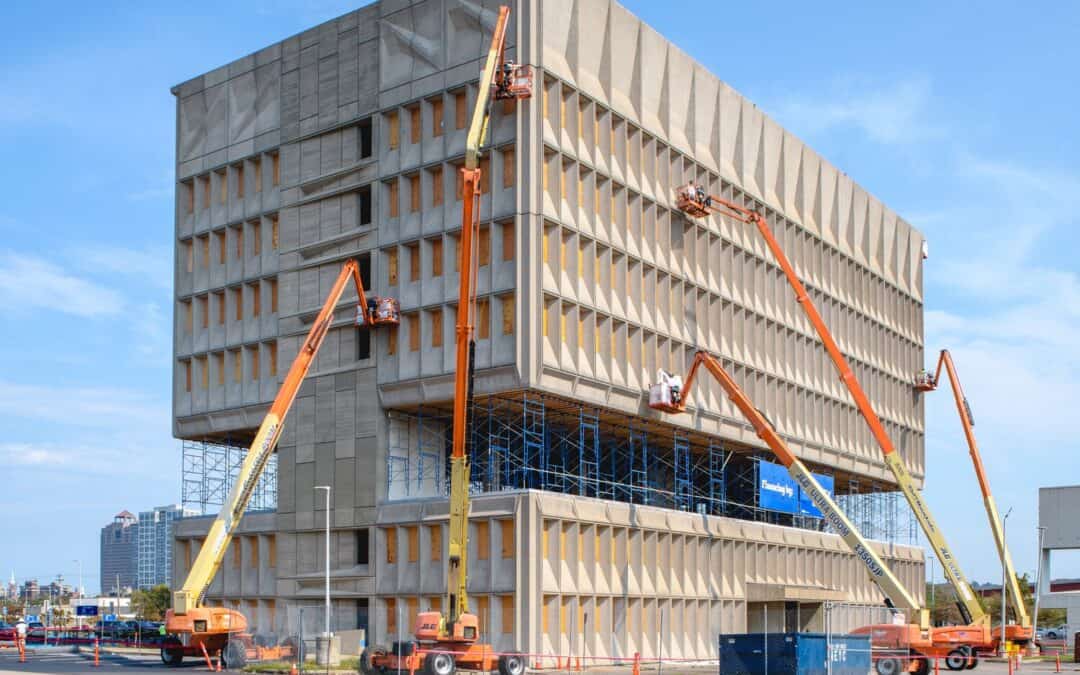Conversion of the Armstrong Rubber Company building in New Haven to a hotel is following the rigorous Passive House energy efficiency guidelines. (Photo courtesy of Becker + Becker)
Christopher Wigren, Deputy Director
Weather-related emergencies have featured prominently in the news during the summer of 2021, with floods in Germany and China, wildfires in California, Oregon, and Greece, and predictions for another busy year for hurricanes, two of which have already brought high winds and flooding to Connecticut’s doorstep.
These events provided the background for the climate report released in August by the Intergovernmental Panel on Climate Change (IPCC), the United Nations body charged with assessing the science related to climate change. The report places the blame for global warming squarely on the use of fossil fuels. Unlike earlier reports, the IPCC document explicitly ties events to the warming climate. Moreover, the report finds that changes are more extensive and are
Programs and resources for sustainability
Connecticut State Historic Preservation Office Resiliency Planning and “Energy Efficiency for Historic Houses” handbook
National Trust for Historic Preservation Research and Policy Lab
Advisory Council on Historic Preservation’s Sustainability Page
accelerating more quickly than previously believed. The IPCC concludes that it is too late to reverse some of the effects already being experienced and calls for immediate and wide-ranging actions to forestall further warming.
Battling climate change is a broad challenge that needs to take place on three fronts. The first two are directly related to energy sources: increasing energy efficiency to reduce present reliance on fossil fuels, and developing alternate energy sources, such as wind or solar power. The third front involves broader measures such as encouraging more compact development to reduce the energy needed for transportation, or even something as simple as wearing sweaters to reduce need for heating.
Finally, there is a fourth area of needed action: measures to cope with the effects of global warming that cannot be reversed, such as changing weather patterns, more frequent and more powerful storms, and rising sea levels—that is, resiliency.
Preservation in an age of climate change
Architect Carl Elefante famously made the case for preservation as sustainability when he coined the motto “The greenest building is the one that is already built.”
Constructing new buildings consumes huge amounts of energy—to collect and process materials, transport them from source to plant to warehouse to building site, and assemble them (not to mention energy required to demolish existing buildings and take away the remnants). The National Trust for Historic Preservation’s Research and Policy Lab estimates that it could take up to 80 years before the operational energy savings of a highly efficient new building outweighed the saved energy of an existing, less efficient one.
In addition, historic buildings were constructed to conserve energy to the extent possible under then-current technologies. They may be oriented to solar warming and light, and their thermal mass can retain warmth in winter and coolness in summer. Operable doors and windows provide natural ventilation. On a larger scale, historic neighborhoods and communities already possess infrastructure such as utilities, transportation networks, and community facilities. Reusing existing saves building new facilities.
Here is a look at some recent efforts to increase sustainability through preservation.
Increasing energy efficiency
Although historic buildings often have energy-conserving features, they still need to improve their performance. In the past decade, preservation projects have significantly reduced energy use in historic buildings by following guidelines from the United States Green Building Council’s LEED (Leadership in Energy and Environmental Design) program, which rates buildings that incorporate energy efficiency measures. Since the Capitol Building in Hartford (1926; NR) achieved LEED certification in 2010—the first Connecticut project using historic rehabilitation tax credits to do so—the program has become common in historic building renovation in the state.
More recently, users have begun upgrading historic buildings to the even more rigorous Passive House standards, which seek to reduce energy use for heating and cooling to
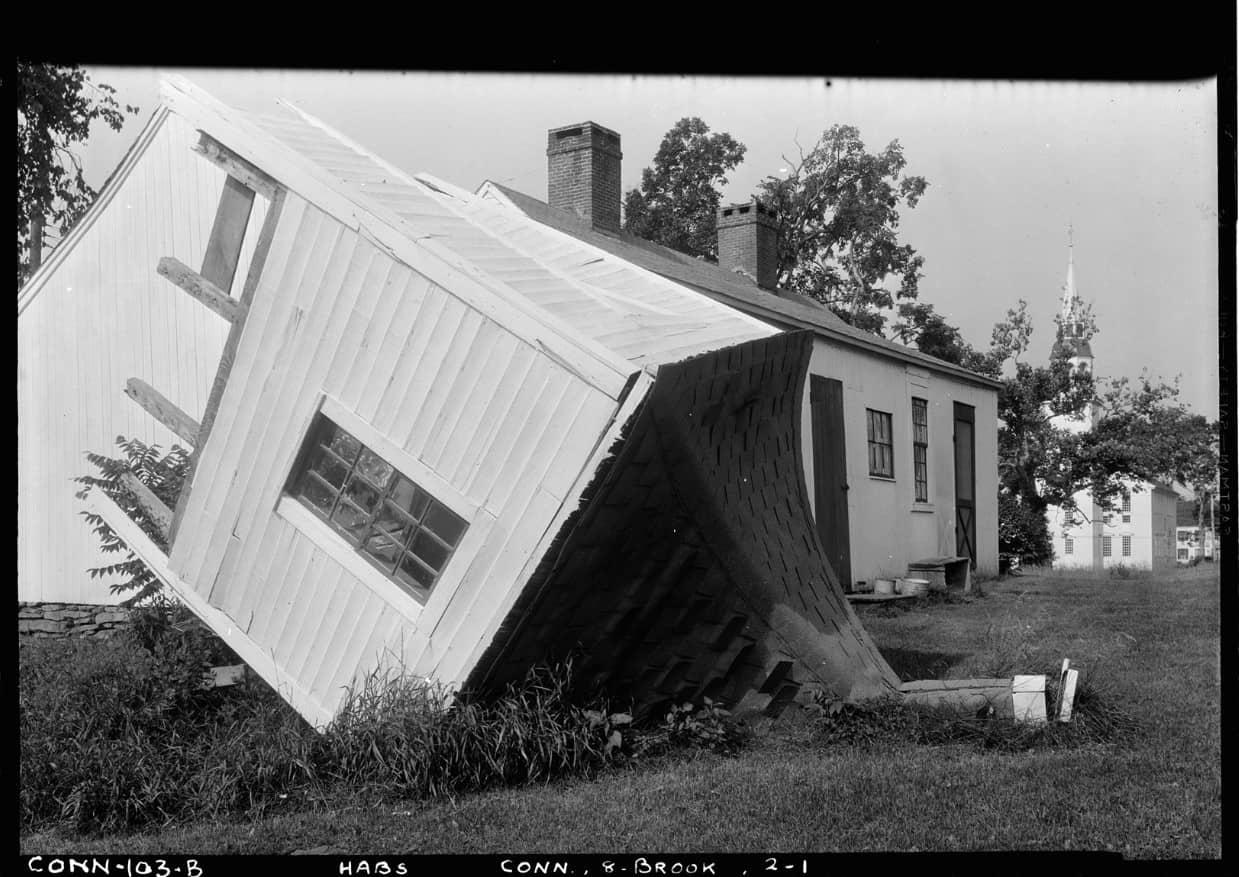
General Israel Putnam’s privy, in Brooklyn, was blown over by the hurricane of 1938, a fate that threatens many more historic structures and communities, due to climate change. (Photo courtesy of Historic American Buildings Survey)
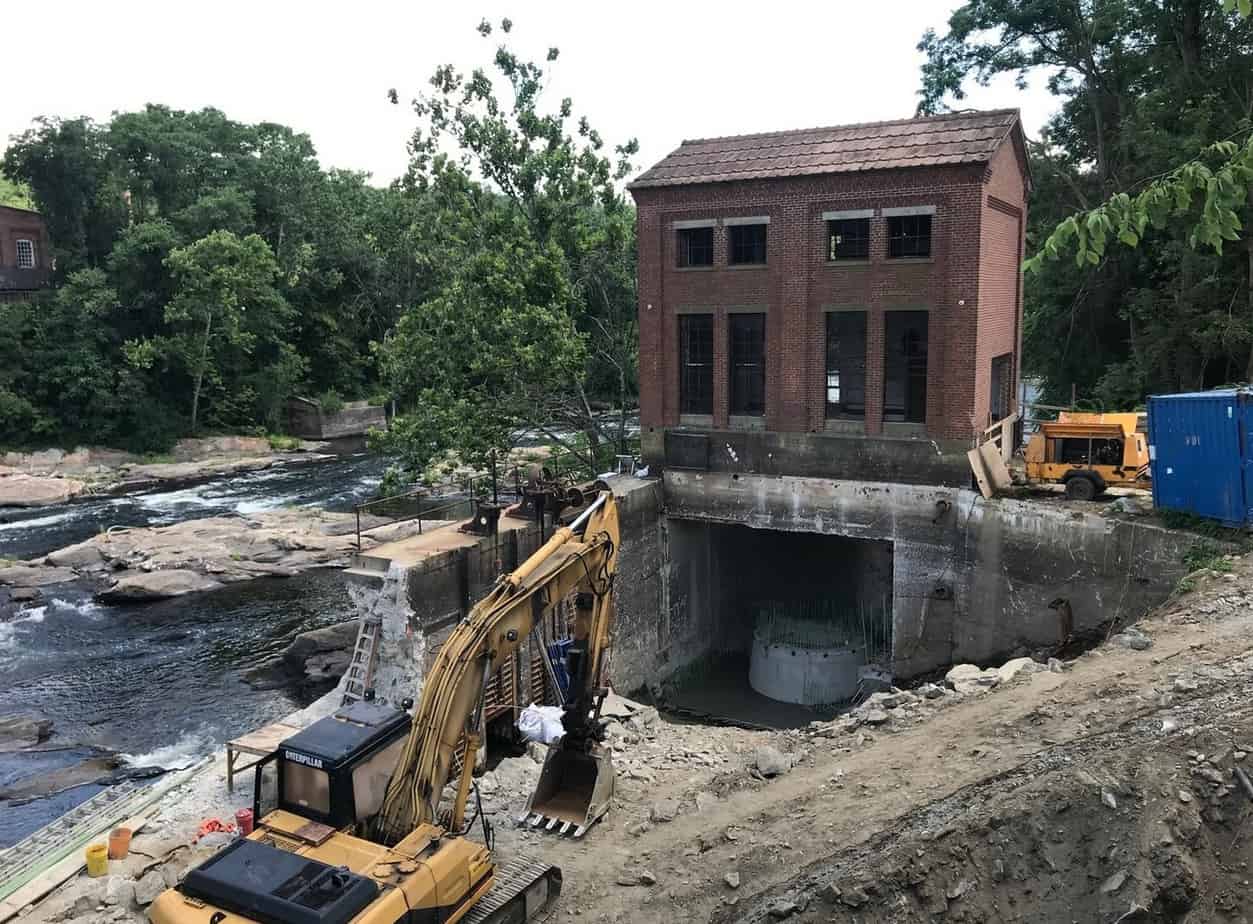
New turbines installed in the historic Collins Axe Company power house, in Collinsville, now generate electricity without burning fossil fuels. (Photo courtesy of Ken Byron)
historic buildings to the even more rigorous Passive House standards, which seek to reduce energy use for heating and cooling to an absolute minimum through such strategies as superinsulation, airtight construction, and high-performance windows. Conversion of the East Haven high school (1936; NR) to the Tyler residential complex was the first multifamily project in the nation to combine Passive House certification and historic rehabilitation tax credits. Currently underway in New Haven alone are Passive House retrofits of the King’s Block (c.1820; NR), requiring approvals from the New Haven historic district commission, and the Armstrong Rubber Company building (1968; NR), being converted to Hotel Marcel using state and federal historic rehabilitation tax credits.
Developing alternate energy
Many historic buildings have experienced changes in the types of energy they or their inhabitants used—from wood and candles to kerosene to electricity from coal- or nuclear-powered generating plants—while retaining their historic character. Solar collectors have become a common sight, and the number of wind turbines across the state is growing. With care, these new technologies are often successfully incorporated into historic settings.
Another opportunity for alternative energy comes from Connecticut’s industrial history, which created dams for waterpower across the state. In Collinsville, the Collins Axe Company dam and power house (NR) have been put back to work by Canton Hydro LLC to generate electricity, saving an estimated 3.2 metric tons of CO2 emissions annually. Canton Hydro modified the dam, first constructed in the 1830s and rebuilt in 1867, and installed new turbines in the power house which dates from the 1930s. The complex process of negotiating approvals and putting together the financing is told by journalist/storyteller Ken Bryon on his website.
In addition to producing electricity without fossil fuels, small-scale hydropower installations contribute to diversifying the energy grid. What’s more, they can generate income to support upkeep of the dams and waterways that are key elements of historic industrial sites.
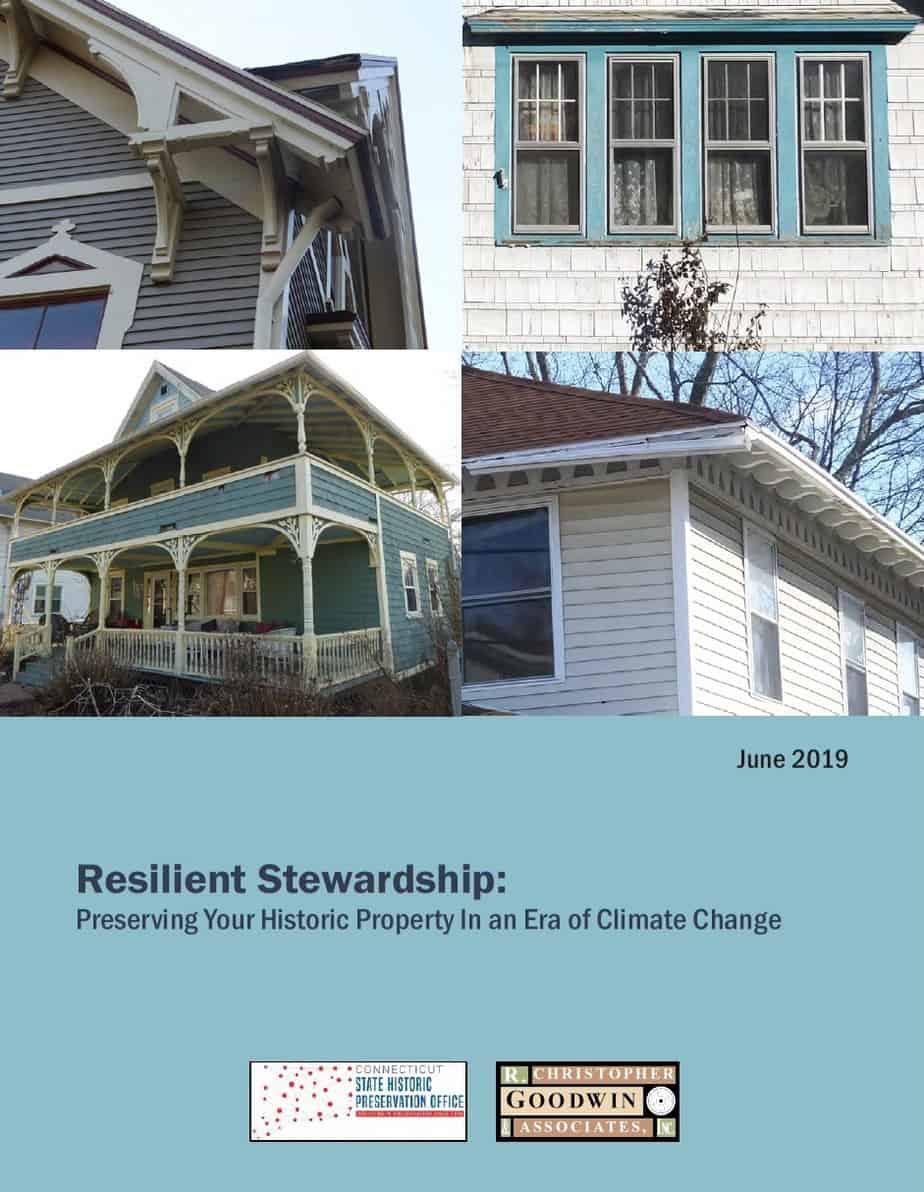
This resilient stewardship guide is part of the Connecticut State Historic Preservation Office’s Resiliency Planning for Preservation program. (Photo courtesy of Connecticut State Historic Preservation Office)
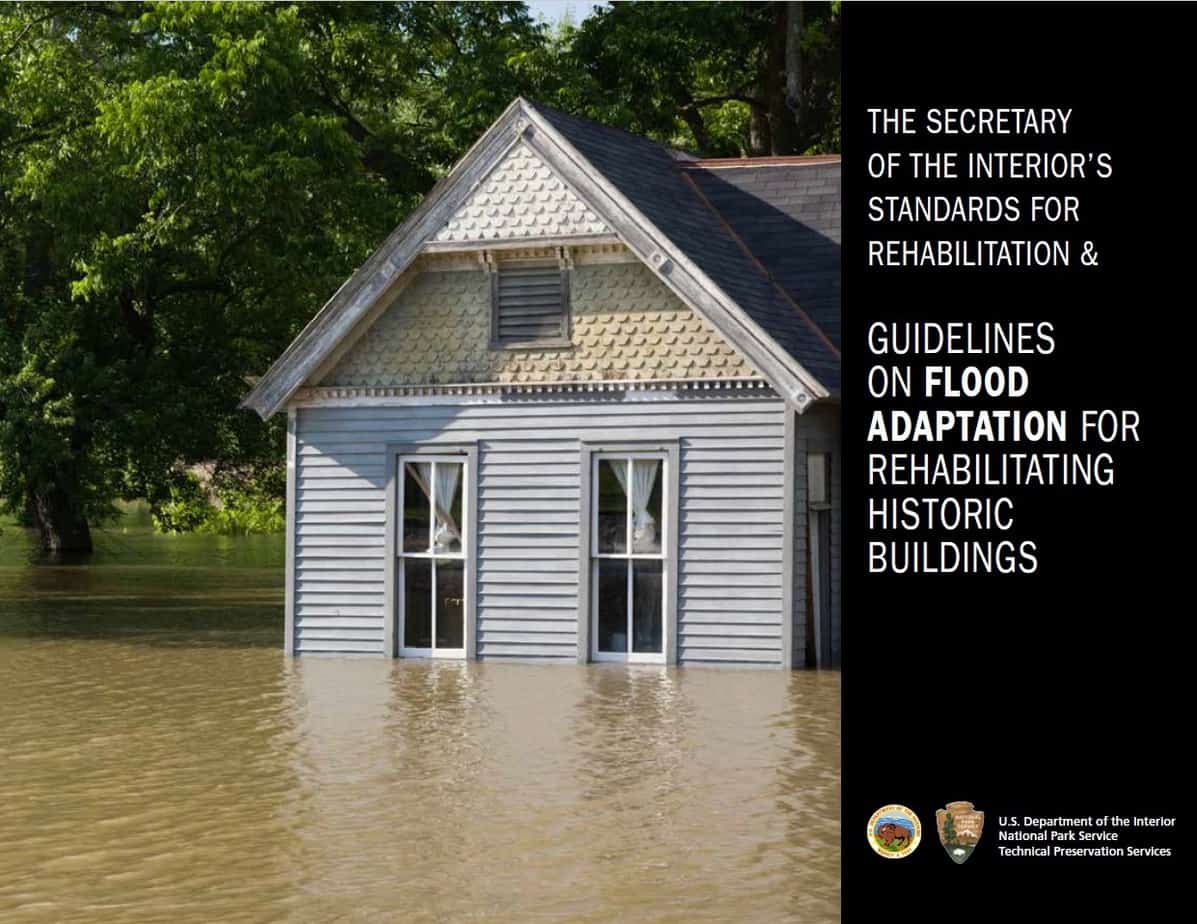
The National Park Service’s Guidelines on Flood Adaptation for Historic Buildings address one aspect of resiliency planning. (Photo courtesy of National Park Service)
Planning for sustainability
Looking beyond individual buildings, community planning can contribute to sustainability. A basic principle is to steer development to areas where infrastructure already exists, saving the energy expenditures needed to develop new roads and utilities. Related to that are trends to more compact development, reducing travel and the need for new transportation infrastructure. Walkable neighborhoods are promoted both for energy savings and for livability.
Preservationists have advocated such development patterns since the 1980s, in the interest of reversing disinvestment in built-up historic areas and stopping sprawl development that threatens rural resources and landscapes.
The zoning reforms presented by Desegregate Connecticut and passed by the General Assembly this year had their origins in social justice but addressed sprawl and sustainability concerns as well. The legislation encourages development in
existing areas already served by infrastructure and transportation through measures such as making it easier to create accessory dwelling units and reducing parking requirements in areas served by public transportation. However, new regulations must be carefully crafted so they don’t create incentives for demolishing historic buildings or overwhelming historic neighborhoods with oversized new construction.
Resiliency
No matter what is done to combat climate change, its effects are already being felt and some of them are irreversible. In Connecticut, the greatest threats come from water—either rising sea levels in Long Island Sound or river flooding from storms. Historic communities built on the water, for transportation, power, maritime trades, or recreation, are increasingly vulnerable.
The Connecticut State Historic Preservation Office completed its Resiliency Planning for Preservation in 2020. The program documents historic resources that are vulnerable to flooding and sea level rise; offers recommendations for incorporating preservation into resiliency planning; and provides guidance for owners of historic properties.
In Bridgeport two pilot projects are underway to protect the South End from rising waters using funds from the Federal Department of Housing and Urban Development Community Development Block Grant Disaster Recovery program. Plans include street regrading and a stormwater park on the west side of the South End; flood risk reduction on the east side of the neighborhood, to include raised streets, flood barriers, and a reconfigured entry into Seaside Park (1865; NR); and a resilience center in the Mary and Eliza Freeman houses (1848; NR).
For owners and stewards of historic places the National Park Service has issued new Guidelines on Flood Adaptation for Rehabilitating Historic Buildings. These guidelines are the latest in a series of publications that provide information about how to apply the Secretary of the Interior’s Standards to specific topics. The new guidelines cover risk assessment as well as various treatments for adapting historic buildings to be more resilient to flooding risk in a manner that will preserve their historic character.
What’s needed?
Preservation, after all, is basically large-scale recycling, and it can make meaningful contributions to addressing the climate crisis. But the severity and urgency of the threat calls on preservationists—along with the rest of the global community—to rethink some of the priorities and methods that have driven our work for over a century.
Adapting to change isn’t new in preservation: while a few purists object to visible light switches or electrical outlets in pre-modern buildings, most of us accept such elements without a second thought. Similarly, solar panels are becoming increasingly accepted. What other changes might we learn to accept, in the name of climate needs?
One area for review is the Secretary of the Interior’s Standards, a set of basic preservation principles created by the National Park Service. By law, federally funded or permitted projects must be evaluated according to these standards; and state, tribal, and local governments also have adopted the Secretary’s Standards for their own preservation work.
Over the years, the Park Service has created guidelines to clarify the application of the Standards to specific topics—most recently the flooding guidelines mentioned above. A set of sustainability guidelines was published in 2011. However, these guidelines are relatively brief and conservative in their approach: where sustainability initiatives conflict with established preservation practice, the guidelines almost always side with existing practice.
As the global climate crisis has become more urgent, there have been calls for the Park Service to review and revise its guidelines—and perhaps the Standards themselves—to address sustainability more fully and more flexibly.
The flooding guidelines suggest how a new approach might be conceived, explaining: “Treatments that might not be considered in other rehabilitation contexts because of their impacts on the historic character of a property may be acceptable in the context of adapting the property to flooding hazards.” In other words, the prospect of flooding may pose such a threat to the very existence of an historic building that it may be necessary to accept some changes that otherwise would not be considered—in the larger interest of preserving the building itself.
It might be argued that the urgency of the climate crisis justifies applying this principle to other sustainability measures for historic buildings, outside of flooding—in the larger interest of preserving the environment in which historic resources and the people who live and work in them must exist.
Other changes might include revising regulations that govern riparian rights to promote greater use of waterpower, as at Collinsville. Or, preservation funding programs might prioritize projects that increase sustainability.
Essentially, what is needed is a change in our conception of what preservation is for. This, in turn, will determine how preservation is to be done. Where preservation in the past was conceived as a way to teach history, to celebrate big-name personages, red-letter events, and high-style architecture, increasingly it is seen also as a means for social action—affirming the history and promoting the full participation of minority and neglected populations in society. In addition to this, preservation must also be a vehicle for combating climate change and promoting sustainability. By taking on these tasks, we also will be affirming the central importance of historic places, not as luxuries for those who can afford them, but as crucial elements of our everyday lives.
This article originally appeared in the September 2021 issue of Preservation Connecticut News.
